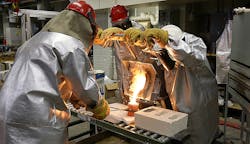WPI Developing Compact, Mobile Foundry
Materials scientists and engineers at Worcester Polytechnic Institute (WPI) are working with the U.S. Army to develop a metalcasting operation suitable for a mobile manufacturing unit, so that military units would be able to produce parts on locations, to cut wait times for parts and thereby increase unit readiness and reduce logistical operations and costs.
The Army’s Expeditionary Lab is compact enough to fit into a shipping container or truck, and it can be moved easily and quickly to bases.
WPI’s research project aims to expand the Lab’s ability to reuse available scrap metals to make critically needed replacement parts.
“This could revolutionize the way we manage wartime operations, reducing our vulnerability in the field,” stated Jianyu Liang, professor of mechanical engineering. “WPI’s research aligns with the Army’s need to be able to fabricate replacement parts from what would otherwise be wasted metal at or near soldiers’ point of deployment to ensure they are prepared at any time and in any theater.”
WPI project began in 2019 when WPI and the Army Research Laboratory received a $1.15 million award from the Strategic Environmental Research and Development Program (SERDP), the environmental science and technology program run by the Departments of Defense and Energy and the Environmental Protection Agency. Researchers were tasked to create an agile manufacturing process that combines existing 3D printing technology, ceramic moldmaking, metal analysis equipment, and a casting process.
Then, scrap metal of the appropriate alloys are melted and poured into molds to create needed parts.
“The project’s innovation is not about the tools,” according to Liang. “It’s about creating a new process that can use existing tools and technology to create a mobile foundry that can rapidly produce a needed part. This innovation has the potential to change military logistics and modern manufacturing by combining multiple tools and processing stages that are typically carried out in separate locations and facilities into a single, integrated system that can be set up and operated in the field. Making it compact and safe within the space allowed in shipping containers is not a trivial task.”
The researchers have used machine learning to analyze a database of steel casting processes (using liquid metals and molds to create parts) for the military; designed models to create new alloys from waste metals for anticipated spare parts; and created a compactable, 3D-printing-enabled rapid-casting steel foundry.
They also have developed methods that Army technicians may use to determine which alloys are needed to make particular replacement parts, and to identify and extract those alloys from available scrap. The technicians will be able to consult a metal-blending model linked to a database WPI researchers have created based on analysis of military scrap metals, to detail the metallurgical composition of parts most commonly in need of replacement or repair.
Also, the WPI researchers developed a process to prescribe the post-casting heat- treatment processes for specific parts to be made.
“Our process has led to the creation of a manufacturing unit with a much smaller footprint than typical models,” according to Liang. “Although we can’t predict what will need to be replaced, by bringing all of these technologies together we can create any part needed on the fly, and we can do it with scrap metal.”
